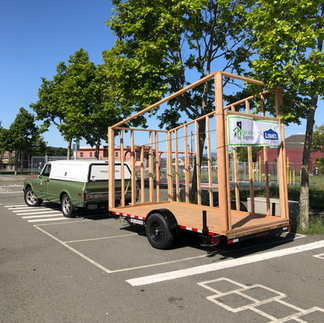Rebuilding Together
- wbdesignloop
- Feb 8, 2023
- 4 min read
Updated: Apr 18, 2023

Rebuilding Together East Bay North
A Design Thinking Approach To The Local Housing Crisis
By John William Frye, Executive Director RTEBN
and Lawrence Grown, Berkeley-Built Managing Editor
Rebuilding Together East Bay-North (RTEBN) fills a critical niche by improving housing for marginalized people in our community. Specifically they perform repairs, renovations, and safety modifications to homes for low-income seniors, people with disabilities, and veterans. RTEBN provides similar services to local nonprofit organizations for their community facilities. Their mission is to bring warmth, safety, and independence to Bay Area communities by revitalizing homes and neighborhood facilities in Berkeley, Emeryville, Albany, and Richmond.
In 1996 the Mayor of Albany, Bill Cain, along with his wife Suzanna Yeh, started an all-volunteer group called “Christmas in April.” The group organized workdays on the third weekend of that month. The workdays were a huge success, and due to the program’s popularity, Bill and Suzanna added work days during other weekends in April, then expanded to a seasonal effort. Originally aiming to provide home repairs for low-income seniors, the program grew to provide services to adults with disabilities, veterans, and the community facilities that serve them. With this evolution, the organization’s name was changed to Rebuilding Together. Over the last three years, the group has further expanded to serve shelters, group facilities, ADUs, and other forms of alternative housing – they are now a year-round workforce of volunteers and community partners!
RTEBN takes a unique approach to their work. Volunteers, early-career professionals, late-career professionals, and residents are integrated into the building development and architectural design process. Every member of the community has something to offer and something to learn; they pass along the information they have, gaining new skills and connections in the process. As a result, people in the community build on their existing skills and RTEBN receives community buy-in from various stakeholders. They approach design, build, and habitation through the lens of multiple stakeholders with the goal of maximizing benefit for all.
There is a shortage of affordable housing in Berkeley as well as the entire Bay Area.
This regional crisis requires a regional solution. The problem is so far-reaching and complex that its solution must be multifaceted. RTEBN uses a comprehensive approach which incorporates all types of housing, including congregate shelters, SROs, hotel conversions, tiny homes, ADUs, and maintenance of older homes.
Design thinking is a human-centered approach to innovation that puts the observation and discovery of hidden or nuanced human needs at the forefront of the process. Folks who need improved housing often need other help as well. RTEBN utilizes the renovation process itself as a tool to build resiliency at all levels of the community.
Some of the first factors to consider at the beginning of community development are how to fund, entitle (get permits, etc.) and construct housing units. RTEBN creates holistic systems so each development success can in turn help kick off the next one. Who can be brought to the table in addition to funders, community leaders, and elected officials? Can individuals and community groups participate in the design and development process? This uplifts the voices of underrepresented stakeholders and provides hands-on training in the hard and soft skills of community revitalization to people who are often shut out of the conversations about their own communities. This also builds resiliency by teaching everyday folks to look at their neighborhoods as evolving commons that they have a role in shaping.
When it comes to the physical labors of construction, moving, cleaning, or other direct services, RTEBN includes universities, workforce development programs, youth volunteers, and early-career contractors alongside seasoned professionals with the explicit intention to pass knowledge along to new generations through hands-on training. For instance, their Estate Cleanout (ECO) and Re-use programs include unhoused staff members in every aspect of the work. This provides opportunities for vulnerable folks to make a living wage while learning additional skills for future opportunities. Also, the goods that are removed are diverted from the waste stream and donated to service organizations such as Habitat for Humanity that collaborate with RTEBN on other projects.
All of RTEBN programming incorporates this human-centric approach to continuous learning and personal development. RTEBN encourages its collaborative partners to adopt the same philosophy throughout their agencies. They do so by earmarking part of their budget for building capacity in RTEBN’s partners. Those partners can then adopt the more labor-and coordination-intensive approach without placing additional financial burdens on their budgets.
RTEBN considers housing initiatives holistically, including the people actually living in them and their end-to-end needs. Those folks might be living with medical, psychological, emotional, and trauma-related issues, within a context constrained by poverty. RTEBN's gateway program matches residents with peer planners to help them meet their goals, and connects them with the appropriate providers to meet their needs.
Rebuilding Together East Bay-North acts as a community engine, taking each project as an opportunity to loop new people into the process, providing job training and community well being while improving the built environment.




















Comments